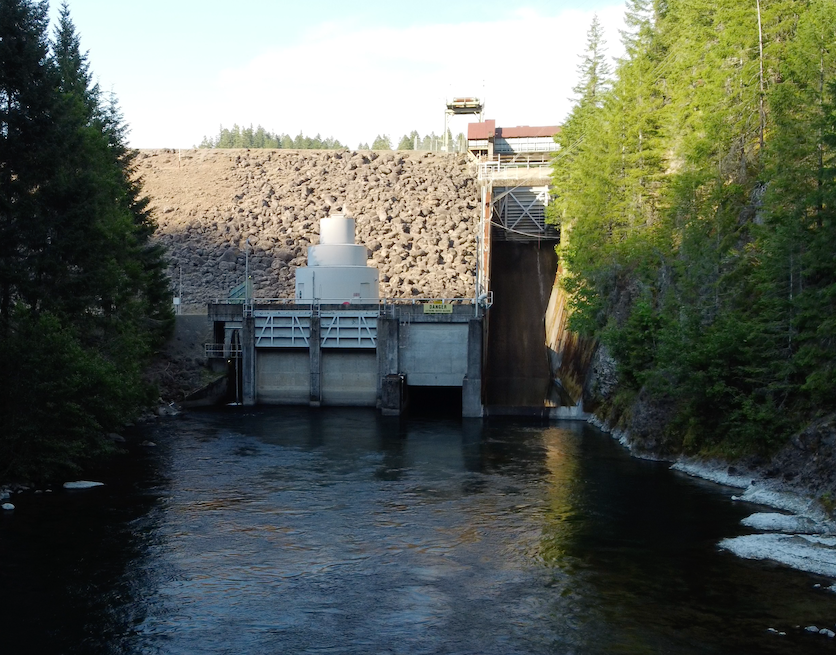Related News
Related News
-
Sustainability Snapshot - Celebrating Energy Efficiency Projects in the Community
Sustainability Snapshops highlight impactful projects completed by EWEB's Customer Solutions department, as a way to celebrate the meaningful work happening behind the scenes.
Find Out More -
EWEB secures $2.5 billion of reliable, affordable, carbon-free energy for customers
The new contract with EWEB’s largest energy supplier, the Bonneville Power Administration, forms the foundation of a diverse energy portfolio.
Find Out More -
Women in STEM: Meet the Hydro Project Engineer Building Habitat for Salmon
EWEB Engineer Associate Val Chang found her way to the McKenzie River from Los Angeles, inspired by heritage trips to the waters of Taiwan and key mentors along the way.
Find Out More -
Public Power Week Poster Contest Winners 2025
The results are in! View the winning posters from EWEB's 2025 Public Power Week Poster Contest.
Find Out More -
EWEB Hometown Heroes compete internationally
Out of 290 teams from 14 different countries, EWEB's Lineman Rodeo team places in the top third of competitors.
Find Out More -
Vote for your favorite Public Power Week Posters
The top five submittals will receive awards. Help us pick the winners.
Find Out More -
Electric Projects underway in North & South Eugene
Underground lines and disaster-resilient power poles are part of EWEB’s infrastructure upgrade near Eugene’s largest natural resource area.
Find Out More -
The Bonneville Power Administration Rate Change and Your EWEB Bill
BPA’s finalized rate increase is smaller than projected, and EWEB’s pass-through adjustment effective October 1, 2025 will now be 2.7% for residential customers—down from the anticipated 4%.
Find Out More -
EWEB completes helicopter installation of salmon habitat features
EWEB adds downed trees and 2,000 tons of gravel to the Uupper McKenzie River below Tamolitch Falls to improve spawning habitat.
Find Out More -
Court rules in favor of EWEB in Carmen-Smith litigation
The U.S. District Court in Eugene has granted EWEB's motion to dismiss a lawsuit brought under the Endangered Species Act pertaining to fish passage at EWEB’s Trail Bridge Dam. The favorable ruling clears the way for EWEB to continue advancing towards implementation of permanent fish passage at the dam.
Find Out More -
Sustainability Snapshot - Ideal Steel July 2025
Our second Sustainability Snapshop highlights a project where EWEB helped a local industrial warehouse upgrade over 1,000 flourescent lights to new efficient LEDs.
Find Out More -
EWEB prepares for wildfire season with risk mitigation measures
EWEB is building a more resilient electric system to weather various types of disasters, from wildfire to winter storms.
Find Out More -
EWEB, Lane County host open house to gather feedback for “Leaburg Transportation Alternatives Analysis”
“What is the Future of the Leaburg Dam Bridge?” open house exhibit on display at Lloyd Knox Park Visitor Pavilion through July 25
Find Out More -
Improving habitat resiliency throughout the Upper McKenzie
Environmental Responsibility is a core guiding value for EWEB decision-making. This summer, EWEB continues its commitment to environmental stewardship with a robust slate of habitat enhancement updates throughout the upper McKenzie River, across the footprint of the Carmen-Smith Hydroelectric Project.
Find Out More -
EWEB weighs multi-billion-dollar decision affecting energy supply
EWEB is weighing energy supply decisions that will cost nearly $2 billion over the next two decades.
Find Out More - Show More
EWEB proposes modified plan for permanent fish passage at Trail Bridge Dam
August 01, 2025 • Aaron Orlowski, EWEB Communications

This article was updated Dec. 11, 2025, to clarify that EWEB's modified plan to build permanent fish passage facilities at Trail Bridge Dam involves building a permanent trap-and-haul facility.
After eight months of extensive collaboration and analysis with scientific experts at two federal regulatory agencies, EWEB is proposing an improved plan to build permanent fish passage facilities at Trail Bridge Dam on the McKenzie River.
Trail Bridge Dam is one of three dams that comprise EWEB’s Carmen-Smith Hydroelectric Project, which is approximately 70 miles east of Eugene. Carmen-Smith provides Eugene with carbon-free electricity and can ramp up power generation to meet about one-quarter of Eugene’s energy needs at times of peak demand, such as winter cold snaps.
Under EWEB’s Federal Energy Regulatory Commission (FERC) license for Carmen-Smith, EWEB must develop permanent passage facilities at Carmen-Smith’s Trail Bridge Dam, aimed at facilitating upstream and downstream passage of migrating Chinook salmon and bull trout. Over the past several years, EWEB has been developing plans for these facilities, including investigating complex dam safety concerns at Trail Bridge following the discovery of sinkholes immediately upstream of the dam. To meet fish passage requirements while these investigations move forward, EWEB – in collaboration with federal and state regulators – has implemented a temporary trap-and-haul program at Trail Bridge Dam.
The planned location of the permanent trap-and-haul fish passage facilities was originally at the base of Trail Bridge Dam. But recent hydraulic modeling of water currents in this area of the river suggested that migrating fish may not easily find the passage facility, prompting EWEB and regulators at the National Marine Fisheries Service and U.S. Fish and Wildlife Service (collectively, the “Services”) to develop a more effective solution.
“We are very grateful to our colleagues at the Services who have worked with us in identifying an alternative solution that we are confident will result in an improved permanent fish passage solution at Trail Bridge Dam,” said EWEB Generation Manager Lisa Krentz.
“When our hydraulic modeling studies demonstrated that the originally agreed-upon location may not be as advantageous to upstream migrating fish, we got to work with our regulators to find a better solution,” Krentz added. “We considered fish migration tendencies to see where they would be most likely to swim, and we identified a new location that we are confident will improve the performance of this component of the Carmen-Smith system.”
The new location of the permanent trap-and-haul facility will be a few hundred feet downstream of Trail Bridge Dam and will include a new barrier system to prevent fish from migrating upstream past the entrance of the fish passage facility.
Construction of the permanent fish passage facility is expected to take several years because of the complexity of the project, including technical studies and FERC approvals related to dam safety and engineering design. The Services will also need to conduct additional review and provide consultation, since Chinook salmon and bull trout are listed under the Endangered Species Act. Barring any unexpected delays, EWEB is targeting completion of upstream fish passage by 2032 – with downstream passage improvements to be placed into service two years earlier, by 2030.
Until these permanent facilities are installed and operational, EWEB will continue to implement the temporary trap and haul program at Trail Bridge Dam, working cooperatively with the Services and state regulators.
“We’ve reached an important milestone with the Services,” said Krentz. “The last several months have been an intensive effort, and we appreciate the collaboration that made this positive outcome possible. We have much work still to do, as we coordinate with our relicensing settlement partners, prepare a FERC license amendment application, and complete facility design and dam safety investigations. But we are very optimistic that a durable, permanent, and effective solution for fish passage at Trail Bridge Dam is well within our grasp. We are proud that we have aligned on a solution that will benefit fish and the community that cherishes them.”
In addition to relocating the upstream fish passage facility and continuing the interim-trap-and haul program, EWEB will be implementing other measures to benefit Chinook salmon and bull trout, including:
- Completing fish habitat enhancement projects at Smith Bypass Reach by 2028.
- Working with fisheries management agencies to reestablish Chinook salmon populations above Trail Bridge Dam.
- Aiding downstream fish passage by maximizing spill, including implementing “full spill” between August 15 and October 31 every year until permanent downstream fish passage is complete.
- Establishing a Fish Enhancement Fund to be used for the benefit of improving habitat and other activities for the restoration of Chinook salmon and bull trout.

